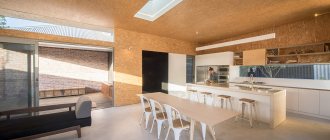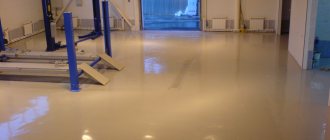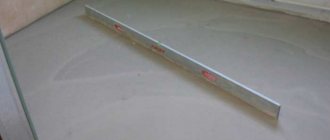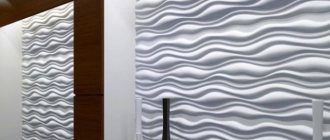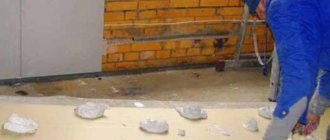A new heating device has appeared on the Russian market, which has been used successfully in Europe for a long time. Warm electric baseboards have great advantages and some installation features. The price of this product is comparable to the cost of heated floors. Are there any clear advantages to this new type of heating, what are the basic principles of installation and is it worth the candle?
Baseboard heater - a compact device that fits into any interior
The design and principle of operation of a warm baseboard
A warm baseboard is a fairly simple device, consisting of an electrical module and a natural shell that does not emit foreign odors when heated.
Electric baseboard diagram
What is a warm baseboard? In general, there is no new word of technology in this device. Just the same principles of electric heating, only in a new design.
Inside the device there are heat exchangers mounted on copper tubes. The whole peculiarity of this device is its compactness. The entire structure fits into a narrow box about fourteen centimeters high and three centimeters wide. Such heaters are installed around the perimeter of the room and can serve as the main and additional means of heating.
Electric baseboard installation
Heated baseboard design:
- tube convector;
- a box with fasteners for attaching heating elements;
- rotating parts.
All these parts of the device are easily assembled into one whole and their installation does not create any problems. The principle of heating a room using this design is also primitive. A heat flow is created along all the walls, which prevents the cold from penetrating into the room. The walls become warm and release thermal energy to the air in the room.
The principle of heating with a baseboard system
Do-it-yourself warm baseboard
When making a warm baseboard with your own hands, you need to consider two possible options for its manufacture:
Option No. 1 – made of roofing copper
In the first case, the structure consists of unannealed copper tubes with a diameter of 12-20 mm and roofing copper sheets 0.4 mm thick. Such systems are assembled in the following order:
- Copper roofing plates must be cut into strips 15 cm wide.
- Then bend the edges of the resulting strips at right angles to the base so that the width of the bent part is approximately 7-8 mm. At the same time, the length of the strip itself should not be more than 3 m, otherwise it will simply be inconvenient to work with such workpieces.
- Then solder the copper tubes to the inside of the case, first bending the ends of the tubes slightly to the side to make it easier to install the adapters.
- The coolant can be supplied using standard hoses having an internal diameter of 12 mm and secured with ordinary pipe clamps.
- After this, homemade skirting boards must be secured to the wall using mounting clips, which must be selected in accordance with the diameter of the tubes.
Option No. 2 – made of aluminum profiles
In another option, the design uses standard aluminum profiles, the same as those used when installing plasterboard structures. In this case, the assembly order is as follows:
- First, you need to make several small holes at the top and bottom of the workpiece through which the profile will be attached to the wall.
- After this, place copper tubes inside it and secure them with aluminum wire.
- Then the profile along with the tubes must be secured to the wall so that one of the tubes is higher than the other.
- To assemble all the fragments into a single system, the easiest way is to use standard connectors, for example, fittings. The front panels in such boxes can be the same profiles, which simply need to be painted in a color that harmonizes with the color of the walls of the room.
Would you like to install a warm baseboard system in your home or apartment? Or do you already heat your house this way? Tell us about your plans or accomplishments in the comments.
Pros and cons of warm infrared electric baseboard
Like every heating system, electric baseboards have their advantages and disadvantages.
Pros:
- The walls in the room where such heating is installed will never become covered with fungus and mold. This effect is especially important for corner apartments, in which two walls face the street.
- The room warms up evenly. The difference in temperature between the floor and ceiling is only one degree.
- Significantly saves space. The walls are freed from bulky radiators.
- Economical energy consumption and high efficiency of the heating system. The electric baseboard consumes only half a kilowatt per two and a half meters of battery.
- The device is considered electrical and fireproof. It can be installed in wooden houses.
- A heating electric baseboard can be installed not only in a room, but also on a glazed terrace, in a winter garden, greenhouse or on a balcony.
- Installing such a heater does not require any special skills and can be done by a novice technician.
- Easy maintenance and reliability of the device.
Advantages of a warm baseboard over a conventional heating system
Thus, heating a room using an electric baseboard has many advantages compared to more conventional systems. But this barrel of honey also has its own fly in the ointment. Such devices cannot be installed in rooms with high humidity. In a bathroom, kitchen or bath room there is a risk of a short circuit of such a device.
Another nuance is the cost of this device. It cannot be said that the price of an electric warm baseboard is less than the cost of the components of a traditional system. But it is worth remembering that all modern highly efficient energy-saving devices are not cheap.
Operating principle and differences
Manufacturers of baseboard heating claim that the system is more economical than all other types of heating. Savings are 20-30%. This happens because lower temperatures are required to achieve a comfortable feeling. This is because most of the heat is transferred by radiation rather than by convection.
Almost all existing heating systems do not create the best thermal picture: warm air accumulates at the top, while cold air remains at the bottom. If the room does not have very high ceilings, the situation is tolerable, but in rooms with large heights this is critical. To equalize the temperature picture, forced convection is used: fans are built into heating devices that more or less effectively mix the air masses. But active air movement carries dust and germs. At the same time, stagnant zones still remain in the corners of the rooms, in which cold air accumulates.
When using baseboard heating there is no thermal cushion at the top, the air is fresh and the feeling is comfortable
Uneven temperatures and dust in the air are not all the troubles of convection heating. There is also dampness that appears on the walls. The fact is that convection heats the air. The walls remain cold. When warm air comes into contact with cold walls, condensation occurs, the walls become wet, and fungi and mold develop. Moreover, this picture is typical for houses and apartments with good insulation.
Baseboard heating works differently
The first important difference: the lower layers of air immediately heat up, which is already comfortable. Gradually and slowly rising up along the walls, the air cools, transferring heat to the walls
Therefore, it turns out that the top is not warmer (or not much warmer) than the bottom.
Only about 20-30% of the heat is spent on heating the air by convection. Everything else goes to heating the walls. And this is the second important difference. The heated air rises along the walls, rather than mixing with the rest (this effect was noticed by the scientist Coand). Therefore, the rising warm flow cuts off the cold from the walls and heats them. Yes, while the walls heat up and dry out, a lot of energy (and fuel) is consumed. But after that the entire surface begins to radiate heat.
This is where the savings zone begins: a person feels comfortable if the wall temperature is 36-37oC and the air temperature is 16oC. We simply feel the heat emanating from the walls with the entire surface of the body. At the same time, the cost of maintaining the temperature of dry walls is low. After all, it is the water contained in the materials that is the best conductor of heat, and the air that replaces it, on the contrary, conducts heat poorly.
This is what one of the options looks like up close
That is why with such heating it is not so important whether there are pieces of furniture along the walls or not: it is mainly the walls that are heated, not the air. Let them take away some of the heat, but then they themselves will begin to give it back. But the walls will heat up anyway.
Types of warm baseboards
Depending on the energy source, heaters are divided into:
- electrical;
- aquatic.
Distinctive features of warm water baseboard
Related article:
Water warm baseboard. In a separate publication we will talk about the design, selection and correct installation of a water-based version of a warm baseboard. Enjoy reading!
Which variety to choose depends on specific conditions. The efficiency of both systems is approximately the same. Electric heating will require powerful protected wiring. The efficiency of heating in the electric version is achieved through the use of a thermostat that controls the operation of the device.
Thermoregulation device
Varieties of warm baseboards
Today, two types of warm skirting boards are sold on the market:
- water;
- electric.
Typically, representatives of both categories are significantly superior to traditional heating methods, but today we will pay more attention to electric models. This is explained by the fact that in most of the villages there are no other sources of energy other than electricity. Of course, it is always possible to organize a heating system using liquid/solid fuel, but it will not be cheap, and certain difficulties may arise (with space for fuel storage, with system maintenance). It is easier to use electrical equipment to heat a room. And from this point of view, an electric baseboard is the most optimal and effective option. Let's take a closer look at this option.
Externally, the electrical system is practically no different from the water one. This is, in principle, an aluminum strip 30 millimeters wide, as already mentioned in the previous paragraph of the article. The height varies between 100-240 millimeters. As for color and shape, they can also be different.
At the same time, the water plinth is a structure made of tubes with stiffening ribs mounted on it, while the electric plinth is an ordinary heating element. The tube itself is quite long (the element takes up almost all the free space inside the case). We also note that the heating element with which the warm baseboard is equipped is made from a special heat-resistant alloy. Thanks to this, the service life also increases.
Note! The operating principle of an electric baseboard is not much different from that of an electric heated floor. Simply put, the system includes a thermostat that controls the temperature in the room, and thermal sensors that control this very temperature (attached to the walls at a height of approximately human height).
Such skirting boards are connected to an outlet, but experts recommend equipping a separate branch for the device from the panel, and also installing an automatic machine.
The modern market for thermostats is very extensive, so, of course, it’s up to you to decide. After all, the cost of the device directly depends on the ease of working with it and the complexity of its implementation. But most buyers prefer models that do not create unnecessary hassle during use. For this reason, it is advisable to choose thermostats that can not only control the temperature in the room, but also program work for the whole day (or even for the next couple of days).
Self-installation of electric baseboards
Installation of electric baseboards takes place in several stages:
Design and calculation
Russian climate conditions require a minimum of one hundred watt heating per square meter of area. With unusually high ceilings and numerous windows and doors, this figure should be increased by about thirty percent. With high-quality insulation of the walls and the location of the room inside the building, the power can be reduced by ten to fifteen percent.
Calculation of the necessary materials begins with measuring the room. Measurements are taken around the perimeter of the room. The resulting footage will be the required length of the heating panels. For example, a room with an area of 36 square meters will require 24 meters of heater with a total power of 3.6 kW.
The warm baseboard is placed a centimeter from the floor
Installation
- A straight line is applied to the walls at a height of one to one and a half centimeters from the floor. This distance will be a technical gap that prevents the device from overheating.
- The back strip of the electric skirting board is applied to the wall, and the places for fastening are marked.
- Holes for fastening elements are drilled into the walls and filled with plastic dowels.
The panel is attached to the wall using self-tapping screws
- The strictly horizontal direction of fastening will be checked with a building level.
- All that remains is to install the supply jumpers and organize the grounding of the heater.
- The final stage will be the installation of the front panels of the device.
Note! You should not connect more than sixteen to seventeen panels to one power outlet. The wiring may not be able to withstand the load.
After installing the electric baseboard, you need to install a thermostatic device.
It is fixed at a height of one and a half meters or at eye level . You can buy an electric warm baseboard in a ready-made version, but you can also make it yourself from hollow aluminum tubes and a heating cable. This type of work will require extensive electrical knowledge, otherwise the device will not be safe.
Installing baseboard heating - a detailed guide
Well, it’s time to talk about the most important thing - about installing a warm baseboard yourself. This procedure, as mentioned above, is quite simple, so you can easily handle the work on your own. But first, let’s look again at what structural elements the device described in the article consists of (the illustration below will help you with this).
Everything is simple, so we won’t stop there. First of all, you must prepare all the necessary materials, which include:
- adapters for connecting sections;
- red/blue protective tube;
- cross-linked polyethylene pipes with a diameter of 1.2 to 1.8 centimeters (required for connection to the distribution manifold);
- special adapters with which plastic pipes will be connected to the section (internal thread, diameter 1?2 inches);
- swivel pipes (they are required for corner installation and are not included as standard).
It is worth noting that the required number of adapters, as well as the duration of the pipes, is determined individually. As for the required tools, these include:
- adjustable wrench;
- hammer;
- wire cutters (they will be used to remove the brass sections);
- scissors;
- hammer drill
Now that everything you need is already available, you can proceed directly to assembling the baseboard heating.
Note! The maximum permissible length of one circuit is in this case 12.5 meters. But this information will not be required if the installation is carried out in accordance with the project, which is calculated and drawn up by a qualified designer.
Step one.
Start installing a warm baseboard by laying pipes, moving from the distribution manifold. Measure the distance to the junction of the collector with the section of the heating device. Next, take the pipe and cut the resulting length from it (be sure to add 20 “spare” centimeters). Lay the pipe (can be either on the floor or on the wall). But it is important that the pipe comes out of the wall 15 centimeters from the nearest corner and 6 centimeters from the floor surface. In addition, the pipes should be located one above the other (blue on top).
Step two.
Now arm yourself with a special self-adhesive insulating tape and glue it around the entire perimeter of the warm baseboard. The next stage is the installation of the aluminum profile. Start this procedure from the corner, cut this profile at an angle of 45 degrees, then proceed according to one of several possible schemes:
- screw it to the wall or floor;
- attach to silicone;
- glue it using double-sided adhesive tape.
Step three. After this, install the clips for baseboard heating. The step between these clips should be as follows:
- First, step back 15 centimeters from the corner and make a hole for the dowel;
- The step between all other clips should be 40 centimeters.
Step four.
Having completed the installation of the aluminum profile with holders around the perimeter of the required room, begin installing the convectors directly. To do this, take a plastic pipe and cut it to the required length. Make sure that it docks with the device section as evenly as possible; in this case, there should be no kinks.
Step five.
Proceed to assembling the coupling. Take copper and plastic pipes, put a nut on them along with a sleeve and a sealing gasket. In addition, place a special sleeve in the plastic pipe. Connect them by hand, then tighten them using an adjustable wrench. Next, attach the radiator to the wall, if necessary, mark where exactly the brass fins will be removed. If available, use wire cutters to remove them, being careful.
Step six.
Take another section and, proceeding in the same way as before, connect it together using an adapter. It is important that the baseboard bodies fit as tightly as possible; there should be no gaps here. But at the corners you must retreat from the edge by about 1 millimeter, otherwise you will not be able to squeeze in decorative elements later.
Step six.
Place it against the wall again and, if necessary, trim off the “extra” radiator fins. Move confidently towards the corner of the room.
Step seven.
To bypass the corner, use special corner connecting tubes. Twist the ends of these tubes as in the case of the coupling. Attach a section of the device, put on the nut along with the bushing and gasket. Twist everything and secure the radiator with clips. Take a wooden block for this purpose and, without applying excessive force, press until the copper tubes fit into the latches. Due to the fact that the metal is thin, it is better not to do this manually (deformation is possible).
Step eight.
Now move on to the last section. It must be looped using a special tube made of corrugated stainless steel. In this case, make the connection in the same way as in the case of all other couplings.
Step nine.
In a similar way, carry out installation around the perimeter of the room, and then secure the baseboard cover. Take electrical tape and stick it on the lid (more specifically, on its inner surface). Attach the latter to the profile and then snap it into place. It is worth adding that in some models fixation is performed using screws.
Step ten.
The time has come to install decorative elements - corner joints and plastic plugs. That's all, the warm baseboard can be considered successfully installed with your own hands!
All you have to do is connect the resulting system to the distribution manifold, and then run the coolant into it. When the network is filled with working fluid, carefully examine it for leaks. If you find that some connections are leaking, arm yourself with a wrench and tighten them. As you remember, there is a rubber seal that is pressed against the edges of the coupling and, as a result, does not allow liquid to pass through. If even this does not improve the situation, dismantle the connection and check whether the rubber seal is damaged. Replace if necessary.
Now you know everything about installing baseboard heating! As you have already been able to see for yourself, there is nothing super complicated and certainly not scary in this procedure. You just need to take the measurements correctly (checking them several times) and strictly follow the instructions above. By the way, don’t forget to watch the thematic video below.
That's all, good luck with your work and have a warm winter!
Electric warm baseboard: price and manufacturers
The costs of electric baseboard heating systems depend on the complexity of the installation and the quality of the materials. The price of an electric warm baseboard ranges from one and a half thousand to four thousand rubles, depending on the power and design.
The color of the heater can be matched to the walls
The most popular manufacturers in this market are the Austrian BestBoard, the Ukrainian Thermia and the domestic Tektrum. Austrian products are distinguished by their quality and aesthetics, but they are also more expensive than others. In addition to these manufacturers, there are many companies offering their products. Before you buy an electric skirting board, you need to carefully read the reviews. Sometimes they help in choosing more than any, even a detailed analysis of prices and technical characteristics.
Installation of a warm water baseboard system
Installation of an electric warm baseboard is very simple: we fix it on the wall. That's it, the system is ready for operation. All that remains is to plug it into the sockets. The main thing is that the cross-section of the wire is correctly calculated and that there are circuit breakers of the correct rating. This is the main problem when using an electric warm baseboard. The water one is much more difficult to install. Everything must be collected into a single system, and this is not easy.
Installation of a heating baseboard: you need to know the nuances
Calculation of baseboard heating
A complete thermotechnical calculation of heating is a long and complex matter. The size and geometry of the room, the material of the walls, floor, and ceiling are taken into account, and the degree of insulation of all structural elements, including windows and doors, is taken into account. In general, the calculation is not at all easy. Therefore, most often they take the average figure, which is derived as a result of the analysis of many calculations.
It is believed that to heat one square meter of room area with average insulation, 100 W of thermal energy is needed. That is, to calculate the power of a warm baseboard, you need to multiply the area of the room by 100. Get the required figure. This is exactly how much (or better, about 20-25% more) should be given in total by all the elements of the warm baseboard.
An example of the technical characteristics of the Best Board warm baseboard for different operating modes of the system
For example, the area of a room is 18 square meters. To heat it you will need 1800 W. Next, we look at how much heat is generated by one meter of heating. A water heating baseboard can operate in different modes; depending on the mode, it emits different amounts of heat. The table above shows data for one of the systems. For example, let's take the heat transfer of one meter of warm baseboard from this table (other manufacturers may have significant differences).
For example, the system will operate with a supply temperature of 50°C. Then one linear meter produces 132 W of heat. To heat this room you will need 1800/132 = 13.6 m of warm baseboard. When ordering, it is better to add a margin of 20-25%. This reserve is necessary so that the system does not work at the limit all the time. This time. And also in case of abnormal cold weather. That's two. So, we take 17 meters with a reserve.
Once again, please note: these are average data for some average house. Moreover, even the height of the ceilings is not taken into account. Again, it is taken as average - 2.5 meters. If your insulation is better, you will need less heat; if it is worse than “average,” you will need more. In general, this method provides only approximate calculations.
How to act
The first thing to do is to draw a plan on which to indicate the length of each heating device and the length of the connecting pipes. After all, the length of a warm baseboard is not always equal to the perimeter of the room. In this case, the sections of heating devices are connected to each other by copper or polymer pipes. It is undesirable to use steel ones, since they chemically interact with copper (it gradually collapses).
Preparation for installation occurs long before its actual start. At the very beginning of the repair, even before leveling the floor, pipes are stretched from the boiler or collector unit to the connection point for the warm baseboard. The pipes are laid, tested for integrity, filled with screed under pressure (working pressure in a private house is 2-3 atm, in a multi-storey house you need to find out from the housing office). Then all repair work is carried out and only after the walls and floor are finished, the installation of warm baseboards begins. Here's the order:
- Heat-reflecting tape is attached along the perimeter of the walls. It prevents heat loss to heat the wall.
Thermal insulation tape is attached, and fasteners are placed on top of it - Fastening elements are installed on top of the tape in increments of 50-60 cm. They are fixed to the wall using dowels or self-tapping screws (depending on the wall material).
- According to the plan, sections of the heating baseboard are fixed in the fastening elements and connected to each other with copper or polymer pipes.
We install the pieces and connect them into a single whole - The tightness of the system is checked using pressure testing.
- If everything is normal, pipes from the collector unit or from the boiler are connected, the system is filled with coolant and tested.
This is what it looks like when it's done - After successful tests, decorative covers are installed and the baseboard heating system is ready for operation.
Actually, installing warm baseboards is not too complicated. But the tightness of the connections is important and special attention must be paid to this.
Price per meter of warm baseboard
| Image | Name | Panel length, m | Power, W | Average price, rub |
| MrTektum | 1 | 200 — 270 | 5100 | |
| MrTektum | 1,5 | 300 — 400 | 7700 | |
| MrTektum | 2,5 | 500 — 675 | 11300 | |
| MrTektum | 5 | 1000 — 1350 | 24900 | |
| MrTektum | 7 | 1500 — 2000 | 33900 | |
| Megador Standard-100 | 1 | 400 | 3600 | |
| Megador Standard-150 | 1,5 | 400 | 4250 | |
| Megador Standard-200 | 2 | 600 | 4750 | |
| TerModule | 1 | 140 | 14400 | |
| TerModule | 1 | 200 | 13300 | |
| TerModule | 1 | 300 | 12000 | |
| TerModule | 1 | 400 | 11800 |
How to install a warm baseboard yourself
Installation of a water heating system begins with the installation of a collector. Two pipes are connected to it (one for supply, the other for coolant intake), powered by the heating unit.
Correct operation of the equipment is only possible if the system maintains a constant pressure of at least 3 atm.
The maximum length of the circuit cannot exceed 12.5-15 m. In cases where a longer circuit is required, an additional collector is installed. The pipes are laid around the perimeter of the room in a prepared base (plank) with thermal insulation.
A gap of at least 1 cm is left between the pipes and the floor. This prevents overheating of the system elements. The modules are fastened using fittings. After installing the pipes, the operation of the system is checked, after which they are closed with a front panel.
The electric heating system is connected directly to the electrical panel. For these purposes, it must be equipped with a separate machine. Wires installed in the system must have a cross-section of at least 2.5 mm. Each circuit has its own thermostat and temperature sensor. Heating baseboards should be located at least 1.5 cm from the wall.
Some installation tips
- Before installing the heater, you need to stick class B1 insulating tape on the wall. It will become additional fire protection.
- Fasteners for electric skirting boards are installed in increments of forty centimeters.
Skirting board connections are made using heat-resistant cable
- All cables and connections used must have a high temperature resistance class - at least B1.
Types of electric skirting boards
A warm baseboard is a kind of compact radiator, which is very small in size and located around the perimeter of the room. Just like classic radiators, baseboard structures can be heated using electricity and ordinary water. For water systems there are serious restrictions: the length of the circuit is no more than 15 meters, the absence of water hammer and the need for complex preliminary calculations.
Design of a water-heated baseboard
All existing types of electric heaters have no restrictions on the area and volume of the room, are easy to install and take up very little space with high efficiency. The most widely used types of heaters are cable and infrared.
Heating elements around the perimeter of the attic space, which will be covered with decorative panels
Infrared skirting board
Compact and economical infrared electric warm baseboard is a small-sized design consisting of a housing, a reflector and a heating element. An IR heater is a device that converts electrical energy into heat. Current from a 220-volt network is supplied to contacts made of copper and silver-plated plates. Through these bimetallic electrodes, the current is transmitted to carbon (made from carbon paste) strips, which convert alternating electric current into infrared radiation.
Heating tape designed for baseboards
IR rays, passing through the film in which the contacts are sealed, heat it and the objects with which it comes into contact. Thus, the film serves as a kind of heat exchanger. The melting point of the film is at least 210 degrees, and carbon contacts heat up by no more than 50 degrees, so IR systems are absolutely safe from the point of view of fire protection.
Infrared heating film device
To make infrared heating more effective, foil insulating materials are used as a substrate for the film, which reflect heat in the desired direction. IR heating is the most economical in terms of energy consumption, safe and easy to install. Among the disadvantages are the high price of the film itself and the need to use a thermostat.
Infrared warm baseboard requires the use of a thermostat
Related article:
Warm floor under laminate on wooden floor. In a separate publication you can find out how heated floors are installed on a wooden base and all the installation nuances.
Cable heater
The main requirement for systems used in plinth structures is small size. An electric heating cable, which is used in most heating systems, is an excellent solution in this case. The basis of such a system is a heating cable - a flexible wire in a multilayer polymer braid.
Heating cable
The current passing through such a wire heats the outer layer to a given temperature. The maximum value is set by the manufacturer and depends on the chemical composition of the polymer from which the cable is made. The thermostat can be set to a lower value.
Application of heating cable in baseboard heating
The heating cable can be used alone or in combination with metal plates that provide better heat transfer. The first option is much simpler and cheaper, but its efficiency is lower due to the small surface area of the cable. Using an aluminum or copper heat exchanger is more expensive at the installation stage, but already in the first heating season the costs are recouped due to significant energy savings.
Radiator heated by cable bundle
What's the result?
Today, electric baseboards are not the most popular type of heating system, but, without a doubt, the situation will change over time. This heater is supported by its efficiency and unique ability to fit into any interior.
Warm baseboard is an excellent solution for a winter garden and veranda
Electric skirting boards are easy to install and safe. You can control the heating temperature using a thermostatic device.
Advantages and disadvantages of baseboard heating
What is the difference between heating using warm baseboards? Warm air flows from the heating element upward along the wall, heating the wall. As it moves upward, the air gradually cools down, then falls down, but not along the wall, but in the center of the room.
The result is that the warmest air is located below the perimeter of the room. The warmest object - besides heaters - is the walls. Also, warmer air is located near the floor. As it rises, it cools down and at head level it is a little colder. The difference is small, 1-2 degrees, but this temperature distribution is better for human well-being.
Uniform distribution of heat over the entire area and volume is one of the most important advantages
Heating using a warm baseboard is inertial. It is impossible to unequivocally classify this property as an advantage or disadvantage. There are both positive and negative aspects. Minus: until the walls warm up, the room is cool. Therefore, such a system is only good for permanent residences and is completely unsuitable for a summer residence. The positive point is that when heated, the walls act as a large stabilizer - they maintain the temperature at the same level, releasing the accumulated heat if necessary. Such a large heat accumulator will help to last for some time even if the heating is turned off.
The advantages of heating systems with heating baseboards include their efficiency. After the walls heat up, the boiler consumes a minimum of fuel - only to maintain the temperature. And such modes are usually more economical. But this applies to any inertial heating system, so this cannot be considered a special advantage of a warm baseboard.
The warm baseboard assembly is a little closer
Baseboard heating also has undeniable advantages. First, this is one of the few systems that provides uniform heating. Even the corners are always warm. Secondly, this is the most inconspicuous system that easily fits into any interior. With all this, heating devices are easily accessible, the system can be repaired at any time.
It has a warm baseboard and an obvious drawback - its high price. This is due to the fact that copper and aluminum are used to increase heat transfer, and they cost a lot.
Main advantages
When it’s cold outside, the issue of heating the room is more relevant than ever.
Unfortunately, central heating is not always able to create a comfortable microclimate in the apartment. In such a situation, you can resort to more efficient methods by installing additional heating. See also: the operating principle of a baseboard heating system.
A wide selection of sizes and colors is one of the advantages of this structure.
Heating baseboard is an excellent solution to the problem. It is possible to use this technology in parallel with other types of heating, as well as independently. In addition, it is small in size and does not take up much usable space. It is possible to install a warm baseboard yourself. Such equipment has many advantages, which include:
- compactness;
- efficiency;
- ease of installation and repair;
- comprehensive heating of the room;
- no effect of dry air;
- aesthetic design;
- wide selection of colors and shades.
How to make baseboard radiators for heating:
Another important advantage is that the baseboard warms up both the floor and the walls, thereby preventing the development of fungus and mold. Thanks to the wide color spectrum, it will fit perfectly into the interior and will not contrast with the floor covering.
Which heating baseboard to choose for heating
When purchasing heated floors, you should pay attention to the product manufacturers. It is better to purchase skirting boards from well-known brands with a long history.
Among the manufacturers that have proven themselves to be of good quality equipment:
- "Mr. Tectum"
- "Rehau"
- "Besta Board".
When installing electric heated skirting boards, it is necessary to first assess the need for electricity consumption and the possibility of connecting the equipment to the network. An important factor determining the choice of heating baseboard is the material of the walls. The typical characteristics of the premises are also taken into account.
Heating a house with a warm baseboard is different from radiators and heated floors.
When installing a traditional heating system, problems with radiators constantly arise.
I would like to hide them somewhere away so that they do not stand out and spoil the interior with their appearance. What if we initially made a system in which batteries would not be needed at all? And we are not talking about heated floors here.
It looks quite a bit different from the usual one. Its height ranges from 14 to 20cm, width about 3cm. With such dimensions, such a system will fit into any interior without any problems.
Is this heat source enough to fully heat a house or apartment? Quite. Despite its small size, do not forget about its length.
So, in a room up to 20 m2, when installing a plinth along three walls, the total area of such a heater reaches 2 m2. At the same time, it is not these square meters that emit heat, but something else.
To find out what exactly, let's take a closer look at the operating principle of a warm baseboard and find out all the details about its effectiveness.
A warm baseboard differs from heating radiators in that it heats up the entire wall and thus forms a thermal curtain or screen.
The heat is instantly distributed evenly throughout the room, and not just near the windows.
Moreover, such a system is suitable for any type of floor. The air in the room does not overheat, does not dry out and does not raise dust.
Many people mistakenly believe that such heating heats the room by convection. Something like floor convectors.
However, this is not at all true. The fact is that convection currents of warm air from the baseboard contribute to heating the room by only 20-30%.
You get unique huge radiators from floor to ceiling inside the house. Therefore, in rooms where the ceilings are low and there is a minimum of furniture, the efficiency of the system is maximum.
In the kitchen it is better to install it under a set that has high legs.
It is often recommended to use it instead of floor convectors for panoramic windows. However, keep in mind that full compensation for the thermal gap in such a place cannot be created with a baseboard!
It's all about radiant energy. Unlike walls, here you will not notice the effect of heat accumulation and distribution. It will not “stick” to the glass, but will immediately go outside.
But with the task of simply eliminating the discomfort of being next to a cold window, skirting boards successfully cope.
The whole system works on the Coanda effect. In 1910, this Romanian aviator, trying to improve aircraft engines, used special plates that were supposed to reflect the heat flow from the fuselage so that it would not catch fire.
However, he got exactly the opposite effect. The warm air did not reflect, but on the contrary, seemed to lick the fuselage. How is this effect used in a warm baseboard system?
The heated air flow from them rises along the wall. Moreover, its speed from below is greater than the speed from above.
That is, the further it moves from the surface of the wall, the less its intensity and speed. And here we need to remember Bernouli’s law with pipes of different sections through which liquid or gas moves.
It states that the minimum flow rate and maximum pressure of the medium will be on a section of pipe with a large cross-section, and vice versa. That is, the faster the flow moves, the less pressure there is.
In relation to a warm baseboard, this means that air flows that move near the wall will have less pressure than at some distance from it. Due to this pressure difference, a force arises that seems to press the warm air against the wall.
Therefore, with baseboard heating, the wall is heated first, and then all objects in the room are heated from it. Real heating of the walls is felt at a height of up to 1.5 meters.
This is what a thermogram of heat distribution over a surface heated by a baseboard looks like in a thermal imager.
As you understand, convection does not play a significant role here. The main factor is the radiation from the heated wall. So-called radiant energy, as in infrared heaters and paintings.
Thanks to this method of heating, the air temperature in the room does not have to be brought up to +24-25C. Even at 20-21C you will feel comfortable. Your walls will be heated several degrees more.
Therefore, the heated wall creates thermal comfort of radiation balance, which a conventional battery cannot create.
However, not everything here is as rosy as it seems at first glance. If your entire wall is heated, then heat loss from it increases.
This means that it must initially be made heat-intensive and strive for maximum heat resistance.
Here, for example, is the formula for calculating heat loss known from a physics course:



